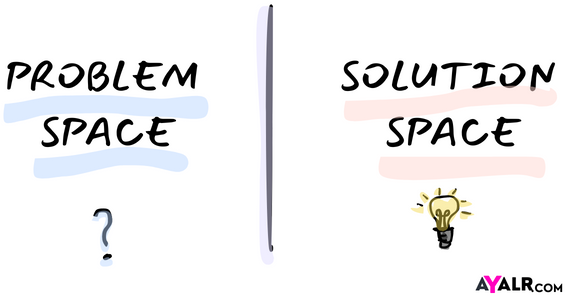
Creating a product from scratch is a complex initiative that demands meticulous effort. Regardless of the product’s nature, crafting it anew entails extensive research, unwavering commitment, considerable time investment, and financial resources.
Rushing or adopting the wrong methodologies during product development often leads to delivering a product that is not market-fit. The haste to deliver can lead to creating superficial nice-to-have features which do not address users’ genuine needs
This article will walk you through the process of creating a product from scratch first by going through all the phases of product discovery, ensuring the creation of impactful products that add value to the users. Secondly, we’ll continue with the product delivery stage which is an iterative process where the first goal will be to deliver an MVP to the market and evaluate the increment with the customers and various stakeholders.
RELATED: What is Product Discovery?
How to Make a Product That Users Love?
The entire Product Delivery Process revolves around the following:
- PRODUCT DISCOVERY
- Aligning the team
- User Research
- Ideation
- Prototyping
- Validating the ideas
- Refinement
- PRODUCT DELIVERY
- Product Development of MVP
- Validation and Testing
- Post-launch and evaluation of MVP
Product Discovery Phase
1: Aligning the Team
When we notice a problem that needs to be addressed we try to investigate possible solutions. That’s why in the initial phase the product team together with the key stakeholders try to develop a shared understanding of the problems and discuss the needs and problems (or pains) that the user experience. This phase is called the Alignment.
During the kick-off meeting which can take from a few hours to a couple of days a common understanding and the following alignment phase outcomes are expected:
- What’s the problem?
- Can we solve it?
- How will we deliver value?
- What will be the ROI?
Reminder: At this point the PMs and key stakeholders should strictly avoid discussing specific features, discuss interfaces, tech stack, or cost. If we jump immediately to the solution space instead of analyzing the problem space we might invest in a product that won’t address any real user need and hence it would be just a nice product that is not market-fit!
While in the Alignment phase, we discuss the problem statement in detail internally. The research phase involves going out and gathering data to test whether the assumptions we have are right, partially right, or wrong.
2: User Research
In the realm of product development, user research stands as a cornerstone, essential for generating fresh ideas and comprehending user requirements and workflows. Prior to embarking on new product development, it’s imperative to employ an array of tools and methodologies to gather user insights and unveil genuine user necessities. Tailoring these techniques to suit the product category, teams can engage in user interviews, observational studies, surveys, and even scrutinize competitors to effectively navigate the research journey. This approach not only informs the development process but also ensures alignment with user expectations.
Several techniques are employed for user research, each offering unique insights into user needs, behaviors, and preferences. Some common techniques include:
- User Interviews: Engaging in one-on-one interviews with users to gain in-depth understanding of their experiences, pain points, and aspirations. This technique allows for open-ended discussions and personalized insights.
- Surveys and Questionnaires: Collecting quantitative data through structured surveys or questionnaires to gauge user opinions, preferences, and demographics. This technique is useful for gathering data from a large user base.
- Focus Groups: Bringing together a small group of users for facilitated discussions and interactions. Focus groups encourage participants to share opinions, ideas, and reactions collectively.
- Usability Testing: Observing users as they interact with a prototype or product, identifying usability issues and areas for improvement. Usability testing provides actionable insights to enhance user experience.
- Persona Creation: Developing fictional user personas based on research findings to represent different user segments. Personas help teams empathize with users and design for their specific needs.
- Empathy Maps: Creating visual representations that capture users’ thoughts, feelings, actions, and aspirations. Empathy maps foster a deeper understanding of user motivations.
- Competitor Analysis: Analyzing competitors’ products or services to identify strengths, weaknesses, and opportunities for differentiation.
- A/B Testing: Comparing different versions of a product or feature to determine which one performs better in terms of user engagement or conversion.
The choice of technique depends on the research objectives, product type, target audience, and available resources. Combining multiple techniques can provide a more comprehensive understanding of user needs and behaviors.
3: Ideation
Now that you understand the problems users are facing, it’s time to transition from identifying problems to finding solutions. To do this, you can gather all the people involved in the project for a meeting. In this meeting, you’ll share the information you’ve collected about the problems and present the potential solutions you’ve come up with.
To make things organized, you can group similar ideas together. Then, your team members can vote for their favorite ideas. The ones with the most votes should be given priority. During this step, focus on figuring out what features will really improve your product.
By the end of this phase, you should have a clear idea of what your product’s vision and goals are.
4: Prototyping
It is time to develop simple versions of your product with specific features. You can test these prototypes within the team or with a small group of people from outside. During this experimentation stage, we aren’t creating the actual end product here but finding the best possible solution to the problems identified earlier.
The key points to remember are:
- Go for low-fidelity mockups: Avoid creating high-fidelity mockups because the goal is to test solutions and validate ideas.
- Prototyping is never a linear process: Don’t expect to find the right solution in a single attempt. The Product Discovery journey involves multiple iterations, experimenting with various methods before identifying the most suitable one for your business and users.
- Involve developers and stakeholders: Including developers is crucial for receiving technical insights that guide you towards feasible solutions, avoiding prototypes that may not work practically. Stakeholders also provide valuable input based on their expertise.
5: Validating the Ideas
Finally, this is the phase where we decide whether the product idea is worth spending your resources, time, and money. Consider validating your ideas and solutions from different angles and using several methods for a better outcome. For example, you can use A/B testing, user interviews, and surveys to see how users would react to your product.
6: Refinement
After you validate your idea in the previous stage, you need to start building an MVP with a prepared set of validated assumptions and ideas that lead you to the Product Delivery Scrum Board. Break the validated ideas into clusters, prioritize them, and plan the development timelines accordingly.
By this point, you’ve already determined the features to incorporate into your MVP, along with features intended for the product roadmap but with a lower priority. During the preceding exploration phase, you would have already established which features are indispensable for the success of your MVP. Distinguishing between user desires and genuine user requirements aids in identifying and ranking features. It’s important to be cautious, as rushing the integration of numerous user-requested features can potentially detriment the user experience and divert focus from the product’s core objectives. Consequently, the features you integrate must align with the overarching goal of your product.
Breaking down the features you want to include in your product roadmap is the next step. This involves listing the users and their corresponding opportunity statements. By providing a detailed breakdown of these features, you create a comprehensive roadmap that guides your product’s development. This ensures that you have a holistic view of what’s to come, preventing any missed opportunities or unaligned features.
A Prioritization Matrix is an invaluable tool at this stage. It helps in gauging the urgency and impact of each feature. By employing this matrix, you can decisively determine what features are absolutely necessary for the MVP launch and which ones can be deferred to later releases. This process enhances your decision-making process, ensuring that your MVP comprises features that maximize its effectiveness while maintaining a lean and focused approach.
With these insights in place, you should be prepared to outline your Minimum Viable Product template. This template will encompass the foundational elements necessary for your MVP. By understanding your business or customer needs, pinpointing pain points, and identifying the features to address these concerns, you can create a solid foundation for your product. This foundation serves as a launchpad for bringing your MVP to market.
Product Delivery
1: Product Development of MVP
When the team is ready to construct the features of the MVP, the Scrum framework emerges as a valuable methodology that aids both in managing the Product Backlog for the MVP and in synchronizing the tasks within each Sprint Backlog, ensuring their alignment with the intended results. Following a Lean Inception, the Scrum framework effectively guides the team through the delivery of the MVP, employing a rhythm of Sprints containing stories (output) and features designed for the Minimum Viable Product, thereby verifying the achievement of the desired business outcome.
Before engaging in Sprint Planning, each feature undergoes a detailed breakdown into user stories. To facilitate this process, the Product Backlog Building (PBB) technique, developed by Fábio Aguiar, offers valuable assistance in dissecting the MVP features into manageable user stories. Essentially, the PBB method enhances the refinement process.
Throughout the duration of a Sprint, the Scrum team dedicates its efforts to the user stories at hand. When the Sprint Review takes place, the team evaluates the advancement of stories, features, and the MVP itself. This session involves a discussion about both the tangible outputs and the overarching outcomes of the project.
2: Validation and Testing
Before the product launch, thorough testing is essential. This encompasses concept development and testing, front-end testing, and test marketing to ensure a well-functioning product.
3. Post-launch MVP
However, launching your MVP is not the end of the journey; it’s just the beginning. Collecting feedback from users post-launch is paramount. This feedback acts as a compass, pointing out areas where your product may be lacking and validating its market relevance. User behavior research gleaned from this feedback informs the generation of new ideas for subsequent product iterations. Continual testing, learning, and measurement remain pivotal in refining your product until it reaches its final form.
In essence, the MVP development stage involves striking a balance between user wants and needs, carefully prioritizing features, and creating a roadmap that aligns with the product’s ultimate purpose. This process requires clarity in opportunity statements, a systematic breakdown of features, effective use of prioritization matrices, and the creation of a solid MVP template. Launching the MVP is followed by a continuous feedback loop that guides iterative improvements based on user behavior research. This holistic approach ensures that your product evolves to meet user demands while staying true to its core objectives.
Subsequently, the Scrum team proceeds to advance methodically, addressing each story and feature incrementally, until all the relevant components of the MVP are deemed prepared. Upon reaching this stage, the MVP is handed over to the end user for implementation. The team then seamlessly transitions to working on forthcoming features and stories, embarking on the next phase of product enhancement—each iteration representing a new opportunity to validate hypotheses and accomplish desired outcomes.

